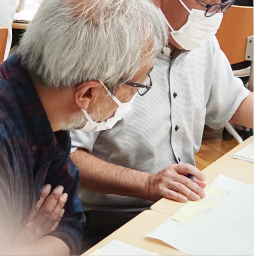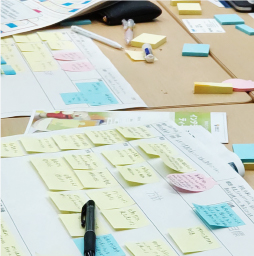How to Develop
This section presents how to develop Teaching Portfolio, Teaching Portfolio Chart, Teaching Statement and Academic Portfolio in the form of a workshop flow. If you would like to attend a workshop in person, please see the Announcements & Events section; there may also be announcements in the facebook group (https://www.facebook.com/groups/TP2007). You can also make a request for an event using the contact form.
Develop your Teaching Portfolio Develop your Teaching Portfolio Chart Develop your Teaching Statement Develop your Academic Portfolio
Develop your Teaching Portfolio
The Teaching Portfolio consists of approximately 8 to 10 pages of text in A4 format and supporting materials to back up the statements in the text.
There are no specific requirements for developing your TP. The first step in developing a TP is to define the purpose and audience for which it is to be written, and to set aside the time necessary to prepare the TP.
Although it is of course possible to develop your teaching portfolio on your own, it is not always easy to keep at it on your own. It is recommended to participate in a short-term intensive workshop where you can be accompanied by a mentor to develop it.
TP workshops are typically scheduled for two and a half days.
The creator (mentee) is accompanied throughout the duration by one mentor who supports the development.
The process from before to after the workshop is as follows.
First, before the workshop starts, mentees work in advance on a pre-task called the Start-up Sheet, and at the beginning of the workshop, they develop their TP charts, and from there, they face themselves in dialogue with each mentor, reflect on their activities and proceeds to write their TPs.
On the final day, there is an opportunity to showcase the completed TP and get to know each other’s TPs. This also serves as an opportunity to broaden your horizons.
The development of a TP allows mentees to look at their own educational activities, rediscover them and identify their future path. It also allows them to build a quality network with each other and renew their enthusiasm for their educational activities.
- Preparation
- Work on the start-up sheet before attending the workshop.
- Day 1
- After an orientation session, you will work on your TP chart. You will then receive one-to-one mentoring with a mentor to reflect on your own activities and find your philosophy. In the afternoon, you will write your TP based on the mentoring. The first draft is submitted to the mentor by the deadline set in the evening. A rough guide is that a table of contents has been drawn up and your teaching philosophy is being organised.
- Day 2
- One-to-one mentoring with a mentor in the morning to deepen the connection between your philosophy and strategy/methodology, followed by writing your TP in the afternoon based on the mentoring session in the morning. A second draft is submitted to the mentor by the deadline set in the evening. The draft is usually finished here.
- Day 3
- In the morning, you will have one-to-one mentoring with your mentor as the same as that of Day 2, and make revisions on attaching evidence, structure, etc. After lunch you will reflect on the qualities and competencies you need as a mentor in a mini-session called ‘To be a good mentor’. The course also culminates in a ‘presentation session’ where participants showcase and learn from each other’s TP. A certificate of completion will be awarded.
- Submission of Your Third Draft
- The workshop is over, but you will submit the third version of your TP, based on the last mentoring, to your mentor in one week to ten days. This will mark the completion of the curriculum for this workshop.


Develop your Teaching Portfolio Chart
TP Chart workshops are normally scheduled for 2.5 hours. An extra hour will be added if you want to brush up on the chart after it has been developed.
There are several opportunities for pair sharing throughout TP Chart workshop. Sharing the contents of your TP chart with your peer can help you to organise your thoughts, and you can also gain a lot of insight from their feedback and from your peer’s TP charts. It is therefore easier and more enjoyable to work on your TP chart than to develop one alone.
There are two versions of TP chart: a paper version and a digital version. Which one you use depends on your preference, but the good thing about the paper version is that writing directly and moving your hand synchronises with your thoughts. The digital version, on the other hand, is better in terms of storage and updating.
- Write Down the Purpose of Development, etc.
- Describe your area of expertise and purposes of development and identify the purpose of your participation today.
- Reflect on Your Teaching Activities
- Write down what you are doing as part of your teaching activities, such as classes you are in charge of and extra-curricular activities. Then list the improvements you have made and the efforts you are making, followed by the results and evaluation. Each item is written on a single sticky note.
- Share in Pairs
- Explain your activity to your partner in pairs. Your partner listen to you carefully so that you can understand the whole activity well by talking.
- Write Down Methodology, Strategy and Philosophy
- List the methods that you do because you think they are common or important to your teaching activities. Then write down the reasons why they do what they do as strategy , and then again the reasons why they do what they do as a philosophy.
- Share in Pairs
- Explain your methodology, strategy and philosophy to you partner. By explaining in a way that links the philosophy to the strategy and methodology, you can become aware of the axis of their activities.
- Check the Evidence
- TP chart is not a document for teaching performance evaluation, but to deepen your understanding of evidence as an important element of TP, you will check if you can provide evidence for each item.
- Share in Pairs (Groups)
- Consider what you would do if you were to ask for evidence about how good your teahicng is.
- Write Down Your Goals and Thoughts
- Write down your short-term and long-term goals based on your awareness of the gap between philosophy and reality. Then, you also write down your thoughts of experiencing the development of your TP chart in the light of the purpose for which you initially wrote it.
- Share in pairs
- Pairs share their goals and thoughts.
- Closing
- Learn about future use and updates and have a question and answer session.


Develop your Teaching Statement
TS workshop is a one-day workshop. In order to participate in, you should bring your own TP chart. First, while reviewing TP charts, the pairs understand each other. This is followed by a lecture on the characteristics and structure of TSs, and then learning about ‘good TSs’ through a case study of one TS. Afterwards, you start to write your own TSs, give each other feedback on their drafts and have time to write again, before finishing.
- Preparation
- Before attending the workshop, you should develop your TP chart.
- Review of your own TP chart
- The workshop will begin with a review of the TP chart.
- Share in Pairs
- During the TP chart review session, there will be two pair sharings. This sharing will help you and your partner to develop a better understanding of your teaching activities.
- Mini-lecture on TS
- By a short lecture on Teaching Statements (TS), you will learn about the purpose, structure and features of writing your TS.
- Correction exercise on TSs
- As a case study, you examine points that could be improved and learn the key points of a ‘good TS’.
- Writing TS
- Start writing your TS, taking into account the TP chart.
- Sharing in pairs
- Pairs share your tentativeTSs and give each other feedback.
- Writing TS
- Further writing based on the feedback from the partner.
- Sharing with different pairs or groups
- Share the tentatively completed TS with a different pair or group than the original pair.


Develop your Academic Portfolio
There are two ways to develop your AP: either you, who already developed your TP wants to extend reflection on your other activities, or you develop your AP directly.
In the case of developing your TP and then extend it to your AP, you work on a more compact version of your TP and a pre-assignment – a start up sheet for the AP – before attending the AP workshop.
If the AP is to be developed directly, a worksheet for a bird’s eye view of the whole activity, called the SAP chart, and a start-up sheet are pre-worked for the workshop.
In both cases, the workshop process is the same as the TP workshop, with the mentee assisted by a mentor.
Mentor Standards
One prerequisite for becoming a mentor is the completion of a teaching portfolio. However, this is not a sufficient condition.
The workshops typically include a session entitled ‘To Be a Good Mentor’, which provides an opportunity for reflection on the qualities of a mentor. This session also results in the publication of a ‘Mentor Checklist’, which summarises the desirable qualities of a mentor as expressed by the mentees.
※written in Japanese


